Astrobotany
Astrobotany is an applied sub-discipline of botany that is the study of plants in space environments. It is a branch of astrobiology and botany.

It has been a subject of study that plants may be grown in outer space typically in a weightless but pressurized controlled environment in specific space gardens.[1] In the context of human spaceflight, they can be consumed as food and/or provide a refreshing atmosphere.[2] Plants can metabolize carbon dioxide in the air to produce valuable oxygen, and can help control cabin humidity.[3] Growing plants in space may provide a psychological benefit to human spaceflight crews.[3]
The first challenge in growing plants in space is how to get plants to grow without gravity.[4] This runs into difficulties regarding the effects of gravity on root development, providing appropriate types of lighting, and other challenges. In particular, the nutrient supply to root as well as the nutrient biogeochemical cycles, and the microbiological interactions in soil-based substrates are particularly complex, but have been shown to make possible space farming in hypo- and micro-gravity.[5][6]
NASA plans to grow plants in space to help feed astronauts, and to provide psychological benefits for long-term space flight.[7]
Extraterrestrial vegetation
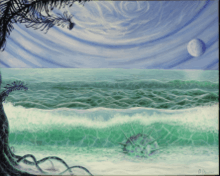
The search for vegetation on other planets began with Gavriil Tikhov, who attempted to detect extraterrestrial vegetation via analyzing the wavelengths of a planet's reflected light, or planetshine. Photosynthetic pigments, like chlorophylls on Earth, reflect light spectra that spike in the range of 700–750 nm. This pronounced spike is referred to as "vegetation's red edge."[9] It was thought that observing this spike in a reading of planetshine would signal a surface covered in green vegetation. Searching for extraterrestrial vegetation has been outcompeted by the search for microbial life on other planets[10] or mathematical models to predict the viability of life on exoplanets.[11]
Growing plants in space
The study of plant response in space environments is another subject of astrobotany research. In space, plants encounter unique environmental stressors not found on Earth including microgravity, ionizing radiation, and oxidative stress.[12] Experiments have shown that these stressors cause genetic alterations in plant metabolism pathways. Changes in genetic expression have shown that plants respond on a molecular level to a space environment.[13] Astrobotanical research has been applied to the challenges of creating life support systems both in space and on other planets, primarily Mars.
History
Russian scientist Konstantin Tsiolkovsky was one of the first people to discuss using photosynthetic life as a resource in space agricultural systems. Speculation about plant cultivation in space has been around since the early 20th century.[14] The term astrobotany was first used in 1945 by Russian astronomer and astrobiology pioneer Gavriil Adrianovich Tikhov.[15] Tikhov is considered to be the father of astrobotany. Research in the field has been conducted both with growing Earth plants in space environments and searching for botanical life on other planets.
Seeds
The first organisms in space were "specially developed strains of seeds" launched to 134 km (83 mi) on 9 July 1946 on a U.S. launched V-2 rocket. These samples were not recovered. The first seeds launched into space and successfully recovered were maize seeds launched on 30 July 1946, which were soon followed rye and cotton. These early suborbital biological experiments were handled by Harvard University and the Naval Research Laboratory and were concerned with radiation exposure on living tissue.[16] In 1971, 500 tree seeds (Loblolly pine, Sycamore, Sweetgum, Redwood, and Douglas fir) were flown around the Moon on Apollo 14. These Moon trees were planted and grown with controls back on Earth where no changes were detected.
Plants

In 1982, the crew of the Soviet Salyut 7 space station conducted an experiment, prepared by Lithuanian scientists (Alfonsas Merkys and others), and grew some Arabidopsis using Fiton-3 experimental micro-greenhouse apparatus, thus becoming the first plants to flower and produce seeds in space.[17][18] A Skylab experiment studied the effects of gravity and light on rice plants.[19][20] The SVET-2 Space Greenhouse successfully achieved seed to seed plant growth in 1997 aboard space station Mir.[3] Bion 5 carried Daucus carota and Bion 7 carried maize (aka corn).
Plant research continued on the International Space Station. Biomass Production System was used on the ISS Expedition 4. The Vegetable Production System (Veggie) system was later used aboard ISS.[21] Plants tested in Veggie before going into space included lettuce, Swiss chard, radishes, Chinese cabbage and peas.[22] Red Romaine lettuce was grown in space on Expedition 40 which were harvested when mature, frozen and tested back on Earth. Expedition 44 members became the first American astronauts to eat plants grown in space on 10 August 2015, when their crop of Red Romaine was harvested.[23] Since 2003 Russian cosmonauts have been eating half of their crop while the other half goes towards further research.[24] In 2012, a sunflower bloomed aboard the ISS under the care of NASA astronaut Donald Pettit.[25] In January 2016, US astronauts announced that a zinnia had blossomed aboard the ISS.[26]
in 2018 the Veggie-3 experiment was tested with plant pillows and root mats.[27] One of the goals is to grow food for crew consumption.[28] Crops tested at this time include cabbage, lettuce, and mizuna.[29]
Known terrestrial plants grown in space
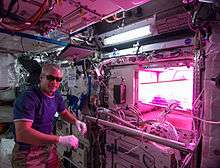
Plants that have been grown in space include:
- Arabidopsis (Thale cress)[30][31]
- Bok choy (Tokyo Bekana) (Chinese cabbage)[32]
- Tulips[31]
- Kalanchoe[31]
- Flax[31]
- Onions, peas, radishes, lettuce, wheat, garlic, cucumbers, parsley, potato, and dill[31]
- Cinnamon basil[33]
- Cabbage[34]
- Zinnia hybrida ('Profusion' var.)[35]
- Red romaine lettuce ('Outredgeous' var.)[36]
- Sunflower[37]
- Ceratopteris richardii[38]
- Brachypodium distachyon[39]
Some plants, like tobacco and morning glory, have not been directly grown in space but have been subjected to space environments and then germinated and grown on Earth.[40]
Plants for life support in space
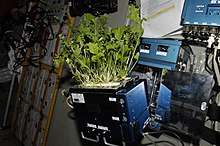
Algae was the first candidate for human-plant life support systems. Initial research in the 1950s and 1960s used Chlorella, Anacystis, Synechocystis, Scenedesmus, Synechococcus, and Spirulina species to study how photosynthetic organisms could be used for O2 and CO2 cycling in closed systems.[41] Later research through Russia's BIOS program and the US's CELSS program investigated the use of higher plants to fulfill the roles of atmospheric regulators, waste recyclers, and food for sustained missions. The crops most commonly studied include starch crops such as wheat, potato, and rice; protein-rich crops such as soy, peanut, and common bean; and a host of other nutrition-enhancing crops like lettuce, strawberry, and kale.[42] Tests for optimal growth conditions in closed systems have required research both into environmental parameters necessary for particular crops (such as differing light periods for short-day versus long-day crops) and cultivars that are a best-fit for life support system growth.
Tests of human-plant life support systems in space are relatively few compared to similar testing performed on Earth and micro-gravity testing on plant growth in space. The first life support systems testing performed in space included gas exchange experiments with wheat, potato, and giant duckweed (Spyrodela polyrhiza). Smaller scale projects, sometimes referred to as "salad machines", have been used to provide fresh produce to astronauts as a dietary supplement.[41] Future studies have been planned to investigate the effects of keeping plants on the mental well-being of humans in confined environments.[43]
More recent research has been focused on extrapolating these life support systems to other planets, primarily Martian bases. Interlocking closed systems called "modular biospheres" have been prototyped to support four- to five-person crews on the Martian surface.[44] These encampments are designed as inflatable greenhouses and bases.[45] They are anticipated to use Martian soils for growth substrate and wastewater treatment, and crop cultivars developed specifically for extraplanetary life.[46] There has also been discussion of using the Martian moon Phobos as a resources base, potentially mining frozen water and carbon dioxide from the surface and eventually using hollowed craters for autonomous growth chambers that can be harvested during mining missions.[45]
Plant research
The study of plant research has yielded information useful to other areas of botany and horticulture. Extensive research into hydroponics systems was fielded successfully by NASA in both the CELSS and ALS programs, as well as the effects of increased photoperiod and light intensity for various crop species.[41] Research also led to optimization of yields beyond what had been previously achieved by indoor cropping systems. Intensive studying of gas exchange and plant volatile concentrations in closed systems led to increased understanding of plant response to extreme levels of gases such as carbon dioxide and ethylene. Usage of LEDs in closed life support systems research also prompted the increased use of LEDs in indoor growing operations.[47]
Experiments
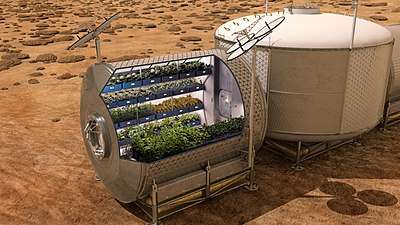
Some experiments to do with plants include:
- Bion satellites
- Biomass Production System, aboard ISS
- Vegetable Production System (Veggie), aboard ISS.[48]
- SVET[3]
- SVET-2, aboard Mir.[3]
- ADVASC
- TAGES, aboard ISS.[49]
- Plant Growth/Plant Phototropism, aboard Skylab[19]
- Oasis plant growth unit[50]
- Plant Signaling (STS-135)[51]
- Plant growth experiment (STS-95)[52]
- NASA Clean Air Study
- ECOSTRESS, 2018[53][54]
Results of experiments
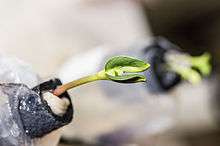
Several experiments have been focused on how plant growth and distribution compares in micro-gravity, space conditions versus Earth conditions. This enables scientists to explore whether certain plant growth patterns are innate or environmentally driven. For instance, Allan H. Brown tested seedling movements aboard the Space Shuttle Columbia in 1983. Sunflower seedling movements were recorded while in orbit. They observed that the seedlings still experienced rotational growth and circumnation despite lack of gravity, showing these behaviors are built-in.[56]
Other experiments have found that plants have the ability exhibit gravitropism, even in low-gravity conditions. For instance, the ESA's European Modular Cultivation System[57] enables experimentation with plant growth; acting as a miniature greenhouse, scientists aboard the International Space Station can investigate how plants react in variable-gravity conditions. The Gravi-1 experiment (2008) utilized the EMCS to study lentil seedling growth and amyloplast movement on the calcium-dependent pathways.[58] The results of this experiment found that the plants were able to sense the direction of gravity even at very low levels.[59] A later experiment with the EMCS placed 768 lentil seedlings in a centrifuge to stimulate various gravitational changes; this experiment, Gravi-2 (2014), displayed that plants change calcium signalling towards root growth while being grown in several gravity levels.[60]
Many experiments have a more generalized approach in observing overall plant growth patterns as opposed to one specific growth behavior. One such experiment from the Canadian Space Agency, for example, found that white spruce seedlings grew differently in the anti-gravity space environment compared with Earth-bound seedlings;[61] the space seedlings exhibited enhanced growth from the shoots and needles, and also had randomized amyloplast distribution compared with the Earth-bound control group.[62]
In popular culture
Astrobotany has had several acknowledgements in science fiction literature and film.
- The book and film The Martian by Andy Weir highlights the heroic survival of botanist Mark Watney, who uses his horticultural background to grow potatoes for food while trapped on Mars.[63]
- The film Avatar features an exobiologist, Dr. Grace Augustine, who wrote the first astrobotanical text on the flora of Pandora.[64]
- Charles Sheffield's Proteus Unbound mentions the use of algae suspended in a giant hollow "planet" as a biofuel, creating a closed energy system.[65]
- In the film Silent Running it is implied that, in the future, all plant life on Earth has become extinct. As many specimens as possible have been preserved in a series of enormous, greenhouse-like geodesic domes, attached to a large spaceship named "Valley Forge", forming part of a fleet of American Airlines space freighters, currently just outside the orbit of Saturn.
See also
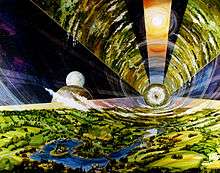
- Bioastronautics
- Biolab
- Bion (satellite)
- BIOPAN
- Biosatellite program
- Endolith – Organism living inside a rock
- EXPOSE – An external facility on the ISS dedicated to astrobiology experiments
- List of microorganisms tested in outer space – Wikipedia list article
- Moon tree – Tree grown from one of the 500 seeds taken into orbit around the Moon by Stuart Roosa during the Apollo 14 mission in 1971
- O/OREOS
- Space food
- Terraforming – Hypothetical planetary engineering process
- The Martian (film) – 2015 science fiction film directed by Ridley Scott
References
- NASA – Growing Plants and Vegetables in a Space Garden
- NASA – Plants in Space
- T.Ivanova, et al. – First Successful Space Seed-to-Seed Plant Growth Experiment in the SVET-2 Space Greenhouse in 1997
- NASA – Getting to The Root of Plant Growth Aboard The Space Station
- Maggi, Federico; Pallud, Céline (2010). "Martian base agriculture: The effect of low gravity on water flow, nutrient cycles, and microbial biomass dynamics". Advances in Space Research. 46 (10): 1257–1265. Bibcode:2010AdSpR..46.1257M. doi:10.1016/j.asr.2010.07.012.
- Maggi, Federico; Pallud, Céline (2010). "Space agriculture in micro- and hypo-gravity: A comparative study of soil hydraulics and biogeochemistry in a cropping unit on Earth, Mars, the Moon and the space station". Planetary and Space Science. 58 (14–15): 1996–2007. Bibcode:2010P&SS...58.1996M. doi:10.1016/j.pss.2010.09.025.
- Rainey, Kristine (7 August 2015). "Crew Members Sample Leafy Greens Grown on Space Station". NASA. Retrieved 23 January 2016.
- F. J. Ballesteros; A. Fernandez-Soto; V. J. Martinez (2019). "Title: Diving into Exoplanets: Are Water Seas the Most Common?". Astrobiology. 19 (5): 642–654. doi:10.1089/ast.2017.1720. PMID 30789285.
- Seager, S.; Turner, E.l.; Schafer, J.; Ford, E.b. (1 June 2005). "Vegetation's Red Edge: A Possible Spectroscopic Biosignature of Extraterrestrial Plants". Astrobiology. 5 (3): 372–390. arXiv:astro-ph/0503302. Bibcode:2005AsBio...5..372S. doi:10.1089/ast.2005.5.372. ISSN 1531-1074. PMID 15941381.
- Limaye, Sanjay S.; Mogul, Rakesh; Smith, David J.; Ansari, Arif H.; Słowik, Grzegorz P.; Vaishampayan, Parag (30 March 2018). "Venus' Spectral Signatures and the Potential for Life in the Clouds". Astrobiology. 18 (9): 1181–1198. Bibcode:2018AsBio..18.1181L. doi:10.1089/ast.2017.1783. PMC 6150942. PMID 29600875.
- "Exoplanet Archive Planet Counts". exoplanetarchive.ipac.caltech.edu. Retrieved 8 April 2018.
- http://astrobotany.com/plants-and-spaceflight/ | Challenges of Growing Plants in Space
- Li, Huasheng; Lu, Jinying; Zhao, Hui; Sun, Qiao; Yu, Futong; Pan, Yi; Chen, Yu; Su, Liang; Liu, Min (2017). "The impact of space environment on gene expression in Arabidopsis thaliana seedlings". Science China Technological Sciences. 60 (6): 902–910. Bibcode:2017ScChE..60..902L. doi:10.1007/s11431-016-0232-7.
- https://www.degruyter.com/downloadpdf/j/opag.2017.2.issue-1/opag-2017-0002/opag-2017-0002.pdf | Agriculture for Space: People and Places Paving the Way
- Briot, Danielle (2013). The Creator of Astrobotany, Gavriil Adrianovich Tikhov. Astrobiology, History, and Society. Advances in Astrobiology and Biogeophysics. p. 175. Bibcode:2013ahs..book..175B. doi:10.1007/978-3-642-35983-5_8. ISBN 978-3-642-35982-8. | The Creator of Astrobotany, Gavriil Adrianovich Tikhov
- Beischer, DE; Fregly, AR (1962). "Animals and man in space. A chronology and annotated bibliography through the year 1960". US Naval School of Aviation Medicine. ONR TR ACR-64 (AD0272581). Archived from the original on 11 August 2015. Retrieved 14 June 2011.
- "First species of plant to flower in space". Retrieved 20 January 2016.
- "No NASA, These Are Not The First Plants To Flower in Space". Retrieved 20 January 2016.
- "Plant Growth/Plant Phototropism – Skylab Student Experiment ED-61/62". Archived from the original on 4 August 2014. Retrieved 9 May 2018.
- NASA SP-401 – Chapter 5
- "NASA – VEGGIE". Archived from the original on 22 December 2018. Retrieved 9 May 2018.
- NASA – Station Investigation to Test Fresh Food Experience
- Why Salad in Space Matters, Jeffrey Kluger, Time, 10 August 2015
- Bauman, Joe (16 June 2003). "USU EXPERIMENT FEEDS ASTRONAUTS' MINDS, TASTE BUDS". Deseret News, Space Dynamics Laboratory.
- "June 17–26 – Diary of a Space Zucchini". Retrieved 20 January 2016.
- Behold the first flower to bloom in space, a cheerful zinnia, Cnet, 18 January 2016
- "NASA Space Station On-Orbit Status 6 February 2018 – Celebrating 10 Years of ESA's Columbus Module – SpaceRef". spaceref.com. Retrieved 8 February 2018.
- "NASA Space Station On-Orbit Status 6 February 2018 – Celebrating 10 Years of ESA's Columbus Module – SpaceRef". spaceref.com. Retrieved 8 February 2018.
- "NASA Space Station On-Orbit Status 6 February 2018 – Celebrating 10 Years of ESA's Columbus Module – SpaceRef". spaceref.com. Retrieved 8 February 2018.
- Administrator, NASA (7 June 2013). "Getting to The Root of Plant Growth Aboard The Space Station". NASA. Retrieved 8 April 2018.
- "Growing Pains". Air & Space Magazine. Retrieved 8 April 2018.
- Heiney, Anna (17 February 2017). "Cabbage Patch: Fifth Crop Harvested Aboard Space Station". NASA. Retrieved 8 April 2018.
- "NASA – A Plant Growth Chamber". www.nasa.gov. Retrieved 8 April 2018.
- "NASA Space Station On-Orbit Status 6 February 2018 – Celebrating 10 Years of ESA's Columbus Module – SpaceRef". spaceref.com. Retrieved 8 April 2018.
- "ISS space flowers may need some help from 'Martian'". Florida Today. Retrieved 8 April 2018.
- "'Outredgeous' Red Romaine Lettuce, Grown Aboard The International Space Station, To Be Taste-Tested By Astronauts". Medical Daily. 10 August 2015. Retrieved 8 April 2018.
- "Photo-iss038e000734". spaceflight.nasa.gov. Retrieved 8 April 2018.
- Salmi, Mari L.; Roux, Stanley J. (December 2008). "Gene expression changes induced by space flight in single-cells of the fern Ceratopteris richardii". Planta. 229 (1): 151–159. doi:10.1007/s00425-008-0817-y. ISSN 0032-0935. PMID 18807069.
- "'NASA Science to Return to Earth aboard SpaceX Dragon Spacecraft". NASA. 1 May 2018. Retrieved 8 May 2018.
- Tepfer, David; Leach, Sydney (2017). "Survival and DNA Damage in Plant Seeds Exposed for 558 and 682 Days outside the International Space Station". Astrobiology. 17 (3): 205–215. Bibcode:2017AsBio..17..205T. doi:10.1089/ast.2015.1457. PMC 5369387. PMID 28263676.
- Wheeler, Ray (1 January 2011). "Plants for human life support in space: From Myers to Mars". Gravitational and Space Biology. 23.
- Wheeler, Ray; Sager, John (8 April 2018). "Crop Production for Advanced Life Support Systems". Technical Reports.
- Lucie, Poulet; D., Massa, G.; R., Wheeler; T., Gill; R., Morrow; C., Steele; T., Swarmer; K., Binsted; J., Hunter (2014). "Demonstration test of electrical lighting systems for plant growth in HI-SEAS analog mars habitat". elib.dlr.de. Retrieved 8 April 2018.
- Silverstone, S; Nelson, M; Alling, A; Allen, J (1 January 2003). "Development and research program for a soil-based bioregenerative agriculture system to feed a four person crew at a Mars base". Advances in Space Research. 31 (1): 69–75. Bibcode:2003AdSpR..31...69S. doi:10.1016/S0273-1177(02)00661-0. ISSN 0273-1177. PMID 12577934.
- Wheeler, R.M. (2000). Mars Greenhouses: Concepts and Challenges (PDF). NASA.
- Nelson, M; Alling, A; Dempster, W. F; Van Thillo, M; Allen, John (1 January 2003). "Advantages of using subsurface flow constructed wetlands for wastewater treatment in space applications: Ground-based mars base prototype". Advances in Space Research. 31 (7): 1799–1804. Bibcode:2003AdSpR..31.1799N. doi:10.1016/S0273-1177(03)00013-9. ISSN 0273-1177. PMID 14503520.
- Morrow, Robert C. (1 December 2008). "LED Lighting in Horticulture". HortScience. 43 (7): 1947–1950. doi:10.21273/HORTSCI.43.7.1947. ISSN 0018-5345.
- "NASA – Station Investigation to Test Fresh Food Experience". www.nasa.gov. Retrieved 23 January 2016.
- Glow-in-the-Dark Plants on the ISS
- Encyclopedia Astronautica Salyut 7
- Plant Signaling (STS-135) Archived 16 February 2013 at the Wayback Machine
- Shimazu T, Aizawa S (1999). "STS-95 Space Experiments (plants and cell biology)". Biol Sci Space. 13 (1): 25–32. doi:10.2187/bss.13.25. PMID 11542477.
- NASA's New Space 'Botanist' Arrives at Launch Site. NASA. 17 April 2018.
- ECOSTRESS – Home web site at NASA.
- SS038-E-000734 (13 Nov. 2013)
- Chamovitz, Daniel (2012). What a plant knows : a field guide to the senses (1st ed.). New York: Scientific American/Farrar, Straus and Giroux. ISBN 978-0-374-28873-0.
- Jost, Ann-Iren Kittang; Hoson, Takayuki; Iversen, Tor-Henning (20 January 2015). "The Utilization of Plant Facilities on the International Space Station—The Composition, Growth, and Development of Plant Cell Walls under Microgravity Conditions". Plants. 4 (1): 44–62. doi:10.3390/plants4010044. ISSN 2223-7747. PMC 4844336. PMID 27135317.
- Driss-Ecole, Dominique; Legué, Valérie; Carnero-Diaz, Eugénie; Perbal, Gérald (1 September 2008). "Gravisensitivity and automorphogenesis of lentil seedling roots grown on board the International Space Station". Physiologia Plantarum. 134 (1): 191–201. doi:10.1111/j.1399-3054.2008.01121.x. ISSN 1399-3054. PMID 18429941.
- "Scientific objectives". Plants in space: GRAVI-2 experiment. 28 March 2014.
- "A decade of plant biology in space". European Space Agency.
- "NASA – Advanced Plant Experiment – Canadian Space Agency 2". www.nasa.gov.
- Rioux, Danny; Lagacé, Marie; Cohen, Luchino Y.; Beaulieu, Jean (1 January 2015). "Variation in stem morphology and movement of amyloplasts in white spruce grown in the weightless environment of the International Space Station". Life Sciences in Space Research. 4: 67–78. Bibcode:2015LSSR....4...67R. doi:10.1016/j.lssr.2015.01.004. PMID 26177622.
- Weir, Andy (2014). The Martian. New York, NY: CrownPublishing. ISBN 978-0553418026.
- Cameron, James, Director. Avatar. Produced by James Cameron and Jon Landau, 20th Century Fox, 2009. Accessed 18 March 2018.
- Sheffield, Charles (1989). Proteus Unbound. New York, NY: Random House Publishing Group. ISBN 9780345344342.
